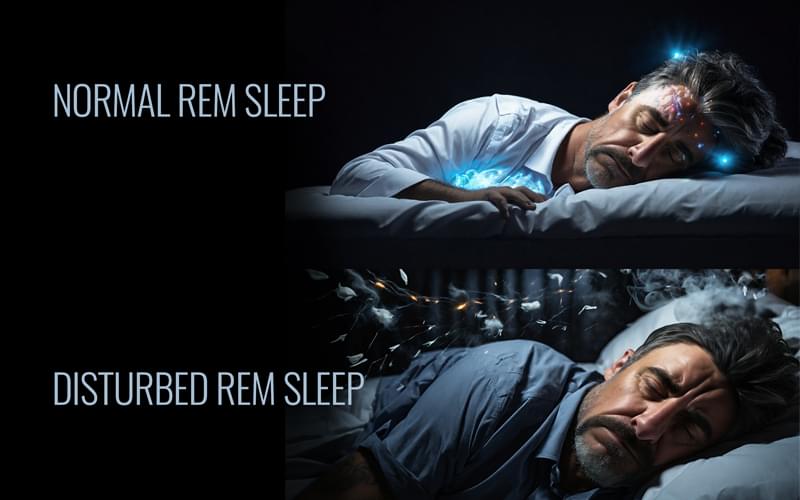

Rapid Eye Movement (REM) Sleep Behavior Disorder (RBD) represents a paradigm shift in our comprehension of sleep pathophysiology, challenging the conventional boundaries between wakefulness and sleep. This condition, characterized by the enactment of dreams due to a failure in the physiological muscle atonia that typically accompanies REM sleep, serves as a vivid illustration of the intricate interplay between neural circuits responsible for the control of sleep states and those orchestrating motor activity. Patients with RBD offer invaluable insights into the neural substrates of dream enactment, bridging the divide between the phenomenological experiences of dreaming and the neurobiological mechanisms that underlie these complex behaviors.
| Feature | Description |
|---|---|
| Pathophysiology | Breakdown in the normal paralysis during REM sleep, leading to physical movement. |
| Clinical Manifestations | Dream-enacting behaviors, which can include talking, laughing, shouting, and even complex motor activities. |
| Diagnostic Criteria | Confirmation typically involves polysomnography that records abnormal muscle activity during REM sleep. |
| Treatment Approaches | Strategies can range from pharmacological interventions, such as clonazepam and melatonin, to behavioral modifications. |
| Associated Risks | Increased risk of neurodegenerative diseases, notably Parkinson’s disease and Lewy body dementia. |
The significance of unraveling the enigmas surrounding RBD transcends mere academic curiosity. A deeper understanding of the disorder offers a window into the early identification of neurodegenerative diseases, given the strong association between RBD and the subsequent development of conditions like Parkinson's disease and Lewy body dementia. This association underscores the urgency for targeted research initiatives aimed at delineating the exact mechanisms by which disruptions in REM sleep physiology precipitate these profound motor enactments. Moreover, elucidating these connections holds promise not only for advancing therapeutic strategies for RBD itself but also for pioneering preventative interventions against a spectrum of neurodegenerative disorders, marking a pivotal chapter in the realm of sleep medicine and neurology.

Dreams, those mysterious narratives that unfold in our slumber, have long intrigued humanity. Anchored in the realm of REM (Rapid Eye Movement) sleep, dreams are a vibrant testament to the brain's complex capacity for creation, consolidation, and cognition. Scientific explorations into the realm of dreams have illuminated their multifaceted roles in memory processing, emotional regulation, and problem-solving. This nocturnal activity, deeply interwoven with the architecture of sleep, offers a fascinating window into the unconscious mind, where the boundaries of reality and fantasy blur, revealing insights into our deepest desires, fears, and unresolved questions. However, understanding dreams is not merely an academic pursuit but a crucial aspect in discerning what is sleep disorders, especially those like REM Sleep Behavior Disorder, where the line between dreams and wakefulness becomes dangerously thin.
The architecture of REM sleep, distinguished by rapid eye movements, low muscle tone, and vivid dreaming, is a critical phase of the sleep cycle, typically recurring every 90 minutes. It is during this stage that the brain processes emotions, consolidates memories, and engages in complex problem-solving. The vividness and emotional intensity of dreams during REM sleep are thought to be products of the brain's attempts to make sense of random signals from the limbic system, the emotion center. This intricate dance of neurological activity not only fosters learning and emotional resilience but also serves as a therapeutic mechanism, allowing individuals to reframe and work through traumatic events in a safe, simulated environment.
Understanding dreams and their connection to overall well-being is paramount in revealing the broader implications of sleep quality on daily life. Disturbances in the REM phase, where most dreaming occurs, can lead to significant psychological distress and underscore the importance of addressing sleep disorders. As research delves deeper into the enigmatic world of dreams and their physiological underpinnings, it becomes increasingly clear that these nighttime narratives play a pivotal role in maintaining mental, emotional, and cognitive health. The exploration of dreams not only sheds light on the human psyche but also highlights the critical importance of safeguarding sleep quality to ensure the holistic well-being of individuals navigating the complexities of modern life.
REM Behavior Disorder (RBD) presents a significant departure from the normal architecture of sleep dreams. Under usual circumstances, during REM sleep, the body is held in a state of atonia, a natural paralysis that prevents the enactment of dreams. However, individuals with RBD experience a malfunction in this system, leading to the physical acting out of dreams. These dreams often possess a vivid, intense, and sometimes violent nature, diverging markedly from the sleeper's normal dream content. This alteration not only affects the narrative and thematic elements of dreams but also underscores the severity of REM sleep disruptions associated with various sleep disorders.
The implications of these disturbances are profound, affecting not only the structure and content of dreams but also the psychological and emotional well-being of the individual. The vivid enactment of dreams can lead to sleep disruption, insomnia, or even injury to the sleeper or their bed partner. This deviation from normal REM sleep patterns signifies a critical intersection between neurological dysfunction and altered dream phenomenology.
Understanding the mechanisms through which RBD distorts dream patterns is crucial for unveiling broader themes related to what is sleep disorders and their impact on human cognition. The loss of muscular atonia during REM sleep in individuals with RBD suggests a complex dysfunction within the neural pathways responsible for regulating sleep stages. This insight into the pathology of RBD offers a glimpse into the intricate balance required for the maintenance of healthy sleep architecture and the role of dreams within it.
Future research endeavors aim to elucidate the precise neural underpinnings of RBD, offering potential for targeted treatments that not only address the disorder itself but also mitigate its impact on dream content and quality. This endeavor is critical, given the importance of REM sleep in emotional regulation, memory consolidation, and overall cognitive function. The exploration of RBD and its intrusion into the landscape of dreams highlights a unique opportunity to understand the interplay between sleep disorders and the enigmatic world of dreaming, offering a pathway toward restoring the natural harmony of the sleep-dream cycle.

Disturbed REM sleep, a hallmark of REM Sleep Behavior Disorder, profoundly impacts daily functioning, embedding itself into the very fabric of an individual's well-being. This disruption in the sleep architecture interferes with the brain's ability to process emotions, consolidate memories, and rejuvenate the body. Individuals suffering from this condition often experience daytime fatigue, reduced cognitive function, and an increased propensity for mood disorders such as anxiety and depression. The crucial role of REM sleep in emotional regulation and memory consolidation highlights the significant repercussions disturbed patterns have on psychological health, thereby, impeding an individual’s capability to navigate daily stressors efficiently.
The correlation between disrupted REM sleep and physical health cannot be underestimated. Research indicates that individuals with REM sleep disturbances are at an elevated risk of developing neurodegenerative diseases, such as Parkinson’s disease and Alzheimer’s. This association underscores the necessity for a deeper understanding of what constitutes sleep disorders and their far-reaching implications on overall health. Furthermore, the physical manifestations of REM Sleep Behavior Disorder, including sleepwalking and other parasomnias, present additional safety risks, exacerbating the daytime consequences of sleep interruption.
In navigating the complexities of life with disturbed REM sleep, individuals face a multifaceted challenge. Beyond the immediate effects on mental and physical health, social relationships and occupational performance are frequently compromised. The sleep fragmentation and subsequent daytime sleepiness impair concentration and productivity, adding stress to professional environments and straining personal interactions. These daily life impacts accentuate the importance of identifying effective treatments and management strategies for individuals suffering from REM Sleep Behavior Disorder, ultimately aiming to restore the intricate balance between sleep health and quality of life.
Approaching the management of REM Sleep Behavior Disorder (RBD) necessitates a multifaceted strategy, intertwining medical, behavioral, and environmental adjustments to mitigate the disruptive and potentially hazardous nighttime episodes. Central to effective treatment is the utilization of medications such as clonazepam and melatonin, which have shown substantial efficacy in reducing the incidence of RBD episodes. Clonazepam, a benzodiazepine, is frequently the first line of pharmacological intervention, offering significant symptom relief. Melatonin, a naturally occurring hormone that regulates sleep-wake cycles, presents a less sedative alternative with promising outcomes in RBD management. It's critical, however, for patients and healthcare professionals to navigate potential side effects and adapt treatment plans to individual needs, aligning interventions with comprehensive health considerations.
Moreover, integrating behavioral strategies into RBD management plays a crucial role. Patients are advised to maintain a regular sleep schedule and create a safe sleep environment, minimizing the risk of injury during episodes. This includes removing potentially dangerous objects from the bedroom and implementing safeguards such as bed rails. Cognitive-behavioral therapy (CBT) has also emerged as a supportive tool, addressing underlying stress or anxiety that may exacerbate RBD symptoms, thereby fostering a more holistic approach to treatment.
Research continues to evolve, driving forward our understanding of RBD and uncovering innovative treatment avenues. Recent studies focus on identifying the root causes of RBD and its association with neurodegenerative diseases, aiming to refine diagnostic criteria and therapeutic strategies. The table below illustrates common treatment modalities and their considerations:
| Treatment Modality | Benefits | Potential Side Effects/Considerations |
|---|---|---|
| Clonazepam | Highly effective in reducing RBD symptoms | May cause daytime drowsiness, dependency |
| Melatonin | Less sedative, regulates sleep-wake cycles | Needs to be used carefully in patients with autoimmune diseases |
| Cognitive-Behavioral Therapy (CBT) | Addresses underlying psychological factors | Requires time and commitment for effectiveness |
Understanding and managing sleep disorders, such as RBD, demand ongoing attention and customization of treatment plans, reflecting the dynamic nature of sleep science.
As scientific inquiry delves deeper into the intricacies of REM sleep behavior disorder and its entanglement with the dream world, the horizon for future research appears both vast and rich with potential. Emerging technologies, such as high-definition brain imaging and machine learning algorithms, are ushering in an era where the neural correlates of REM sleep and the phenomenological aspects of dreaming can be explored with unprecedented precision. This advancement promises not only to elucidate the fundamental mechanisms underpinning these phenomena but also to unveil the complex interplay between neurological structures and dream content.
Furthermore, the exploration of genetic predispositions and environmental factors contributing to the manifestation of REM sleep behavior disorder holds promise for the development of personalized medicine approaches. By identifying biomarkers associated with the disorder, researchers are paving the way for early detection and intervention strategies tailored to the individual's genetic makeup. This personalized approach could significantly enhance the efficacy of treatment regimens, thereby improving the quality of life for those affected.
In addition to improving diagnosis and treatment, future research aims to unravel the protective mechanisms of REM sleep against neurodegenerative diseases. Preliminary studies suggest a link between disordered REM sleep and an increased risk of conditions such as Parkinson's disease and Alzheimer's. Investigating this relationship further could uncover crucial insights into the neuroprotective roles of REM sleep, opening new avenues for the prevention and management of neurodegenerative disorders.
The interdisciplinary collaboration between neuroscientists, psychologists, computational biologists, and sleep medicine experts is another thrilling prospect for advancing the field. Such collaborative efforts are expected to foster innovative approaches to study REM sleep and dreams, bridging gaps in our understanding and translating theoretical knowledge into practical solutions for REM sleep behavior disorder. As the boundaries of what we know continue to expand, the future of research in this domain promises not only to solve the mysteries of today but also to pose intriguing questions for the generations of tomorrow.

270 Pine Mountain Rd Ste 5 Hudson NC 28638
(828) 757-8282